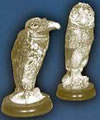Professional thieves in and out in six minutes forcing exhibition closure
|
Ealing Council’s Pitzhanger Manor-House has had to temporarily close its Martinware Pottery exhibition after a professional burglary wiped out their collection.
Thieves broke into the house at around 2.50am on Thursday, 22nd March and stole 22 items, which have an estimated value of £240,000. They also stole the replica top of the Martinware Fountain.
The thieves got in through a window behind the Martinware Fountain. This allowed them to gain access to the room where the fountain was on display and then enter the Martinware room. The alarm log shows the thieves were in and out within six minutes.
The council is appealing for anyone with information on the theft to come forward. The unique pottery has increased in value in recent years which has made it more appealing to professional art thieves.
Martinware Pottery is a very distinctive type of stoneware pottery created by the four Martin Brothers from the 1870s through to the early 1900s. The brothers were best known for their bird sculptures and ‘grotesque’ pieces, including jugs and vases.
Director of Cultural Services Peter Lipman said: “The council deeply regrets that such a valuable public collection has been targeted by thieves.
“Pitzhanger Manor-House has an extensive alarm system but it is clear that the thieves knew exactly what they were looking for as they were in and out within minutes.
“Because of the importance of this collection, the Martinware room is temporarily closed and the remaining pottery is being stored off-site and will not be shown until the room is made secure. Because the house is a listed building this may take some time to do.
“The council apologises for any inconvenience this may cause and appeals for people’s patience during this time.”
Ealing Council's History of the Martinware collection
The four Martin brothers, Wallace, Walter, Edwin and Charles, were pioneers in the production of studio pottery, some beautifully formed and expertly decorated, some eccentric, such as their famous bird jars. They specialised in salt-glazed stoneware, a strong, non-porous pottery with a distinctive 'orange-peel' texture. Having trained as a sculptor, Wallace Martin started producing pottery in Fulham in 1873. In 1877, the brothers moved to a disused soapworks on the canal in Southall. The family continued making pottery until Wallace's death in 1923.
The brothers regarded themselves as artists and each piece of their work is unique. It was popular with collectors right from the start and the brothers had a number of wealthy patrons.
John Hull Grundy (1907-1984) was born in Southall and collected Martinware from childhood. He studied art at Kings College, London and Chelsea School of Art and later taught at the Royal College of Art. During the Second World War he joined the Royal Army Medical College and later became a lecturer in Entomology.
Anne Hull Grundy, nee Ullmann, was the daughter of a Nuremburg family who had been forced to flee Nazi Germany and had settled in Hampstead. She built up her own art collection, specialising in jewellery and Netsuki. It was John who inspired Anne's interest in the Martin Brothers and she soon became a leading authority and enthusiast. Through their local connections and by scouring salesrooms, they built up a large collection of Martinware.
In 1980 Professor and Mrs Hull Grundy offered their entire remaining collection of Martinware to the borough in the form of a bequest. This unique collection is on display at Pitzhanger Manor-House and is a significant part of the borough's cultural heritage. The Hull Grundy bequest consisting of some 260 items was received in 1986.
April 4, 2007
